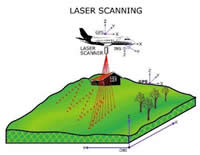LiDAR System Used
LiDAR (Light Detection And Ranging) data is collected by a well
defined flight plan through a specified location. (Appendix Figure
A1) LiDAR is a method of detecting distant objects and determining
their position or other characteristics by analysis of pulsed laser
light reflected from their surfaces. LiDAR works on the same principle
as RADAR (Radio Detection And Ranging), but LiDAR uses light waves
emitted by a laser (rather than radio waves) to gather data. In
its simplest form, LiDAR is used to determine the distance from
the laser to a given object.
 |
| Appendix Figure A1. LIDAR Data Collection (Renslow 2001) |
The data for the study site was collected by TerraPoint which
flew a multiple-return scanning laser altimeter in a small fixed-wing
aircraft with a circa 0.9 meter on-the-ground laser spot, nominal
across- and along-track pulse spacing of 1.5 meters, and 50% overlap
of adjacent flight lines, providing an average of circa 1 pulse/square
meter. Some of these data (Bainbridge Island) were acquired for
Kitsap PUD in 1996-1997. Average pulse spacing of the Bainbridge
data was similar.
The data are in Stateplane projection, Washington Sorth zone FIPS
zone 4602. The vertical datum is NAVD88, horizontal datum is NAD83
HARN. Horizontal units are US Survey Feet. Raster cells (grid cells,
image pixels) are 6 ft square. Elevations are recorded in integer
feet.
|







